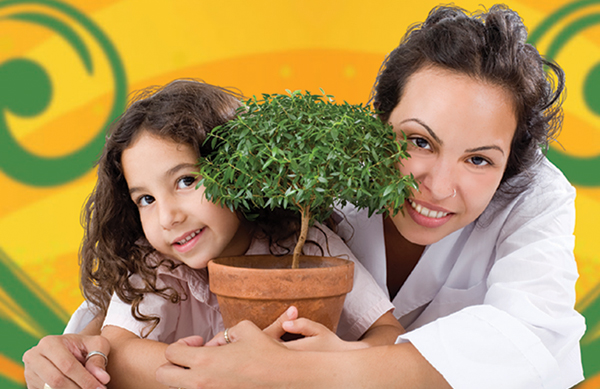Greener Classrooms Create Smarter Kids
 Next time you visit your child’s school — regardless of grade level — don’t just focus on whether there are enough books and computers in the classroom; look to see how much greenery is around. Studies show that having live plants inside the classroom can boost learning skills and reduce stress. “There’s strong evidence that maintaining and enhancing green space in a youngster’s environment has multiple benefits,” says Den Gardner, executive director of Project EverGreen, a nonprofit organization representing groups and individuals associated with the ‘green’ industry.
Next time you visit your child’s school — regardless of grade level — don’t just focus on whether there are enough books and computers in the classroom; look to see how much greenery is around. Studies show that having live plants inside the classroom can boost learning skills and reduce stress. “There’s strong evidence that maintaining and enhancing green space in a youngster’s environment has multiple benefits,” says Den Gardner, executive director of Project EverGreen, a nonprofit organization representing groups and individuals associated with the ‘green’ industry.
Computers can teach kids many skills, but they can’t substitute for nature. Watching Animal Planet and other environment programs on television simply isn’t the same as viewing a natural scene, whether through a window or the true touch-and-feel variety. “Technology is good and it can help our lives, but let’s not be fooled into thinking that we can live without nature,” says Peter Kahn, a University of Washington psychology professor who has researched the effects of natural scenes, such as reduced heart rates and stress levels. Here’s how a classroom with a green view can help your child perform better in school:
Increased learning:
According to a study published in Environment and Behavior, a green environment helps children think more clearly and enables them to refocus their attention when distracted. Green spaces also relieve symptoms of ADD, thus resulting in better concentration, reports the Department of Health and Human Services. European research has found that benefits even extend to university settings where attendance improved, test scores rose, and behavioral problems were reduced by more than 60 percent in classrooms with plants as opposed to non-plant environments.
Improved ability to handle pressure:
A study from the University of Illinois found that girls exposed to green settings are more adept at handling peer pressure, sexual pressure, and other challenges. They also perform better academically. According to Nancy Wells, assistant professor of design and environmental analysis at Cornell University, “Access to green areas helps reduce stress and aggression in urban environments and helps children cope more effectively with life’s stresses at school and at home.”
Better atmosphere for learning:
“Green spaces foster social interaction and promote social support which translates into more friends and increased self-esteem for students, whether they live in urban or rural settings,” says Wells. Elementary schools are finding that planting gardens, digging in the dirt, and seeing the results of those efforts reap more than flowers and vegetables for the students. Tending gardens generally results in socially adjusted children who are happier and perform better in the classroom. A University of Illinois study supports the claim that giving children a view of greenery results in better school outcomes.
Improved health and well-being:
Teaching children how to plant, mulch, and water trees gives them tools for long-term health and demonstrates the impact that plants have on their community in a social, economic, and environmental sense. Wells adds, “When children become truly engaged with the natural world at a young age, the experience is likely to stay with them in a powerful way, shaping their subsequent environmental path.”
Parents can make a difference:
Parents are the most likely allies to help implement this simple but often overlooked strategy for improving school performance once they realize the positive impact of greenery in the classroom. If you’d like to take action, talk with school personnel about developing a plan for adding living plants to classrooms and public spaces, both indoors and out. Parents can work through campus volunteer organizations to provide plants, and teachers can follow up with lessons created around observing and maintaining greenery to fulfill class assignments.
Science-based explanations
Sure, plants are pretty to look at and even fun to care for, but what does science show as reasons for these results? The answers might lie in basic horticulture facts, such as:
- Plants give off water thus increasing humidity levels that make dry heated or air conditioned environments more comfortable.
- Plants have a calming influence. Studies have shown reduced anxiety, as well as reduced headaches and fatigue, with the presence of indoor plants.
- In classrooms with hard wall and floor surfaces, broad leaf plants cut noise pollution by absorbing and reflecting sounds.
- Tight, energy efficient buildings retain more of toxic compounds like benzene and formaldehyde, but indoor plants absorb these volatile compounds from the air.
- Plants can boost creativity, improve mood, and lower blood pressure.
WIN a Green Snack Bag
Sick of wasting money and littering the landfills with plastic snack bags? Inspire a ‘green’ classroom with reusable snack bags by lil’ alice (lilalice.weebly.com).
The 7-inch zip opening allows for tiny, sticky fingers to easily grab snacks! This bag allows food to stay fresher, longer. Click here for your chance to win!









